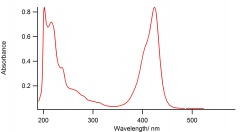3,3′-Diethylthiacyanine iodide
By: Mohanad Ahmad
This experiment, a particle in a box, intends to measure the maximum UV absorbance, λmax, which will allow us to estimate the size of the box, the molecular frame, in which the compound 3,3′-Diethylthiacyanine iodide can exist. A small amount of 3,3′-Diethylthiacyanine iodide dye was dissolved in methanol and its absorbance was measured using a UV/Vis spectrometer. The structure of these dyes is complex in that the carbon backbone may contain several double bonds, i.e. pi bonds, that will introduce conjugation into the system. Conjugation affects the λmax of these dyes because it will cause a blue shift in their spectra. When two double bonds are conjugated, four pi-molecular orbitals are formed, two occupying the HOMO orbital and two occupying the LUMO orbital. Increased conjugation brings the HOMO and LUMO orbitals closer, reducing the energy gap between them. Therefore π to π* excitation will require less energy to occur. As a result, this shifts the spectra of the dye towards higher wavelengths. Figure 1 shows the structure of 3,3′-Diethylthiacyanine iodide, and figure 2 shows the respective UV spectrum. λmax of this dye was at 424 nm which was smaller compared to the other dyes tested in this experiment. This was accounted for by the fact that this dye has only one double bond in its carbon backbone and it's not a part of a conjugated system. Therefore, no blue hsifts occurred for this dye.
